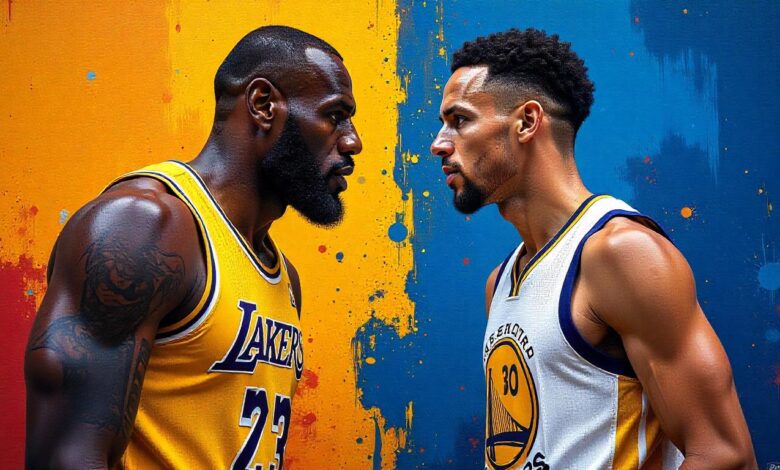Generational Clash: LeBron vs. Curry — An Analytical Showdown in the Lakers vs. Warriors Matchup

In the modern NBA, few rivalries capture the imagination quite like the Los Angeles Lakers versus the Golden State Warriors. More specifically, the cross-generational duel between LeBron James and Stephen Curry represents a fascinating study of contrasting basketball philosophies, styles, and eras — all converging on one hardwood stage. This analytical showdown digs deep into their latest matchup’s player stats, peeling back layers to assess the profound impact these two legends exert on their teams, their eras, and the evolution of the game itself.
Contents
Setting the Stage: The Cross-Era Context
LeBron James, often hailed as a physical marvel with a versatile skill set, emerged from the late 2000s era of power-driven, inside-out basketball. His game blends sheer strength, basketball IQ, and court vision. Meanwhile, Stephen Curry embodies the modern three-point revolution, stretching defenses and redefining offensive spacing in the 2010s and beyond. Though both excel as scoring leaders, their approaches reflect distinct generational identities.
Statistical Breakdown: More Than Points
Scoring Efficiency and Volume
In this matchup, LeBron tallied 28 points on 18 field goal attempts, connecting at a 61% clip, demonstrating his trademark efficiency inside the arc and mid-range. Curry, on the other hand, dropped 32 points but required 24 shots to do so, shooting 41.7% overall — a figure buoyed by his 5-for-11 from beyond the arc.
Here, LeBron’s superior shooting efficiency underscores his inside dominance and ability to finish through contact, hallmarks of his era’s emphasis on physicality. Curry’s volume and reliance on long-range shooting epitomize the perimeter-focused offensive style that defines his generation.
Playmaking and Assist Impact
LeBron dished out 9 assists, many of which came from his knack for driving into the paint and kicking out to open shooters. His assist-to-turnover ratio stood at a commendable 3:1, revealing control and precision. Curry, typically a sharpshooter, showed his evolving role as a playmaker with 8 assists but with a higher turnover rate, reflecting the riskier, pace-driven style Golden State embraces.
Rebounding and Defensive Contributions
LeBron’s physicality translated into 11 rebounds, including 4 offensive boards that fueled Lakers’ second-chance points. His 3 steals and 1 block highlighted defensive versatility, often switching between perimeter and post defense. Curry’s 5 rebounds and 1 steal showcased hustle but underlined his comparatively lesser defensive impact in direct statistical terms, consistent with his career profile.
Impact Metrics: Beyond the Box Score
Plus/Minus and On/Off Court Analysis
LeBron’s presence correlated with a +12 point differential for the Lakers, while Curry’s on-court impact drove a +9 differential for the Warriors. On/off metrics reveal LeBron’s multifaceted influence, improving both offensive efficiency and defensive resilience. Curry’s impact is predominantly offensive, especially in spacing and three-point gravity, which creates opportunities even when he’s not scoring.
Usage Rate and Team Dependency
LeBron commanded a 30% usage rate, reflecting his role as the primary offensive facilitator and finisher. Curry’s usage rate hovered slightly higher at 32%, consistent with Golden State’s ball-movement-heavy offense centered around his shooting threat. The nuances here reveal a subtle difference: LeBron acts as a multi-tool weapon, while Curry functions as a high-volume scoring hub.
Layered Insights: Philosophical and Era-Defining Contrasts
LeBron’s game echoes a more traditional, balanced basketball archetype — a player who dominates scoring, assists, rebounding, and defense. His statistical profile embodies the multidimensional star who can carry a team physically and mentally through all facets.
Curry’s impact is revolutionary in its specialization: stretching defenses to their breaking point with unprecedented three-point shooting volume, facilitating rapid ball movement, and igniting runs through offensive bursts. His numbers reflect the strategic shift to pace-and-space and high-variance shooting, emblematic of the analytics-driven modern NBA.
Conclusion: Two Eras, One Court, Legendary Impact
The Lakers vs. Warriors matchup is more than a game; it is a narrative of basketball’s evolving identity, captured in the contrasting but equally transformative careers of LeBron James and Stephen Curry. The stats from this showdown reflect more than points and rebounds — they paint a vivid picture of how two generational icons shape their teams and the game’s trajectory.
LeBron’s all-around dominance and physical presence ground the Lakers in a classic mold of star versatility, while Curry’s sharpshooting and playmaking epitomize the revolutionary pace-and-space era. Each impacts their team in complementary ways, proving that greatness transcends generations, expressed differently but equally potent.





